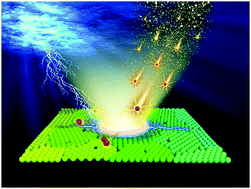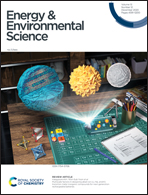Boosting the oxygen evolution reaction using defect-rich ultra-thin ruthenium oxide nanosheets in acidic media†
Abstract
Developing low cost and highly active catalysts for the oxygen evolution reaction (OER) in an acidic medium is urgently indispensable for proton exchange membrane water electrolyzers (PEMWEs). Herein, we have prepared ultra-thin RuO2 nanosheets (RuO2 NSs) using a simple molten salt method. The as-prepared RuO2 NSs with a thickness of 1–2 nm possess abundant defects. Toward the OER, the RuO2 NSs achieve an extremely low overpotential of 199 mV at a current density of 10 mA cmgeo−2 with a loading of 125 μg cmgeo−2. Furthermore, the RuO2 NSs exhibit specific and mass activities of up to 0.89 mA cmoxide−2 and 0.52 A mgRu−1 at 1.46 V vs. RHE, which are 14.9 and 80.6 times enhanced in specific and mass activity as compared to the commercial RuO2 nanoparticles, respectively. In a homemade PEMWE, with RuO2 NSs as the OER catalyst, the electrolyzer achieves a current density of 0.93 A cm−2 at a cell voltage of 1.65 V without iR drop correction, which is 3 times larger than that of the commercial RuO2 catalyst (0.31 A cm−2). Density functional theory calculations indicate that the Ru vacancy on the RuO2 NS surfaces significantly weakens the binding energy of O* with respect to that of OOH*, which decreases the energy cost in the transformation from O* to OOH*, and thus dramatically enhances the OER performance. The unique defect-rich structure and outstanding performance demonstrate that the RuO2 NSs possess great potential for developing high-performance PEMWEs.



 Please wait while we load your content...
Please wait while we load your content...